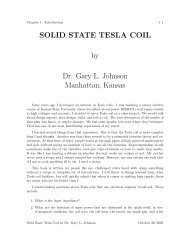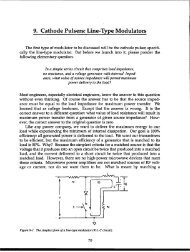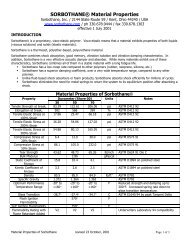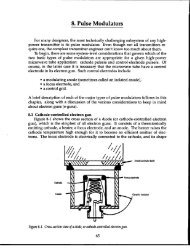3.6M north10.pdf - Dean-O's Toy Box
3.6M north10.pdf - Dean-O's Toy Box
3.6M north10.pdf - Dean-O's Toy Box
Create successful ePaper yourself
Turn your PDF publications into a flip-book with our unique Google optimized e-Paper software.
162 High-Power Microwave-Tube Transmitters<br />
screen)<br />
Virlusl Cathods<br />
‘ Real cathode<br />
Figure 10-8. How current density in region between anode and outermost grid is affected by the spacing<br />
between thent and effective drive voltage, due to the creation of a virtual cathode between the electrodes.<br />
ably low spark-down rate. Already it is obvious that there will be a degree of<br />
flexibility in what the usable anode hold-off voltage really is. In an application<br />
where a switch-tube arc is tantamount to disaster, an extremely conservative<br />
value must be used that will probably be even less than the manufacturer’s<br />
suggested operating voltage. Even this number is already somewhat less than<br />
the “absolute-maximum independent rating,” which defines voltage-hold-off capability<br />
at essentially no plate current.<br />
The useful load voltage is affected by load current as well. Maximum load<br />
current depends upon the type of cathode, its surface area, and temperature,<br />
which is related to heating power; and the current split between anode and other<br />
electrodes, such as the grid, shield grid, and semen grid. Although basic cathode<br />
research is ongoing and types capable of sustaining high emission densities over<br />
long lifetimes have come forth, power-grid-tube cathodes are still of two basic<br />
types: thoriated tungsten (directly heated) or oxide-coated (unipotential, or indirectly<br />
heated). (Million-hour emission lifetimes can at least be projected from<br />
today’s data bases for dispenser-type cathodes.) As current from the cathode<br />
increases, so must the minimum voltage between anode and outermost grid in<br />
order to avoid formation of a “virtual cathode” in the space between the two.<br />
Such an occurrence would prevent the passage of electrons through the region.<br />
(The electrons will not even leave the cathode unless there is adequate effective<br />
drive voltage.)<br />
Figure 10-7 relates cathode emission density to grid-cathode spacing and effective<br />
drive voltage. (The last parameter includes the contributions of anode,<br />
screen, and control-grid voltages as they are weighted by their respective amplification<br />
factors.) Figure 10-8 shows how the current density in the region between<br />
the outermost grid and anode is affected by drive voltage and spacing<br />
between the anode and outermost grid. These relationships can be defined by<br />
the equation<br />
\







